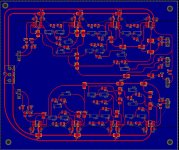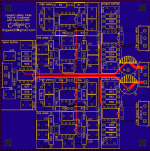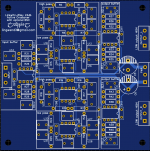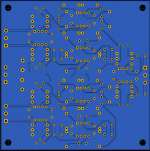I am a beginner. I am designing PCB on easyeda for an active analog crossover.
I read many documents regarding separation of ground planes for different parts
of a circuit. I am still very confused.
I am trying to make separate ground plane for power(dc 15+/-) and signals. Trying to use a simple 2 layer board where the bottom is ground plane.
Will physically making 2 ground planes like the one I made (pictures below) work? Or will there be no need?
Any advice will be appreciated.
Kay.
I read many documents regarding separation of ground planes for different parts
of a circuit. I am still very confused.
I am trying to make separate ground plane for power(dc 15+/-) and signals. Trying to use a simple 2 layer board where the bottom is ground plane.
Will physically making 2 ground planes like the one I made (pictures below) work? Or will there be no need?
Any advice will be appreciated.
Kay.
Attachments
Sorry for the delayed reply, but I think a single plane will do fine at these signal levels, as there is ~.1~.5mA of signal current to ground per opamp unit in most instances/applications.
I initially was going to do a star ground for mine, but based on some research and looking at successful projects decided that a ground plane would be a good solution at these signal levels.
Here's a peak at mine, but it's all through-hole-
I initially was going to do a star ground for mine, but based on some research and looking at successful projects decided that a ground plane would be a good solution at these signal levels.
Here's a peak at mine, but it's all through-hole-
Attachments
Hi Kaytata,
Honestly you don't need to use a ground plane at all. You may find it best to use a 2 sided board and route your ground directly. Often I would do this using very wide grounds (0.1 to 0.2") down the middle and then tap from that as needed.
Ground plane isolation is best when mixing digital and analog circuits AND using multi-layer boards. It keeps the noise from the digital from coupling to analog circuits.
More importantly IMHO would be using separate voltage regulation stages for your L and R channels, to reduce the chance of crosstalk. In this case, use a star ground / star power.
That is, from your board's main DC inputs, branch off to your L and R voltage regulators, and keep your L and R ground separate from there until the outputs.
In some circuits, having a ground plane under parts can actually be a negative.
Honestly you don't need to use a ground plane at all. You may find it best to use a 2 sided board and route your ground directly. Often I would do this using very wide grounds (0.1 to 0.2") down the middle and then tap from that as needed.
Ground plane isolation is best when mixing digital and analog circuits AND using multi-layer boards. It keeps the noise from the digital from coupling to analog circuits.
More importantly IMHO would be using separate voltage regulation stages for your L and R channels, to reduce the chance of crosstalk. In this case, use a star ground / star power.
That is, from your board's main DC inputs, branch off to your L and R voltage regulators, and keep your L and R ground separate from there until the outputs.
In some circuits, having a ground plane under parts can actually be a negative.
Ground planes are also useful to reduce the sensitivity to external RF fields, so if there is no good reason not to use one, just make a ground plane.
Marcelvdg
I did a lot of analog, 12 to 15 V designs with lots of op amps for relatively electrically noisy environments. Stray noise in a metal enclosure was never an issue. By noisy I meant nearby proximity to 1/2 HP motors, and high voltage power supplies for motion picture projectors.
I would rather use the double sides for routing than ground planes, but do what you like.
Best,
E
I did a lot of analog, 12 to 15 V designs with lots of op amps for relatively electrically noisy environments. Stray noise in a metal enclosure was never an issue. By noisy I meant nearby proximity to 1/2 HP motors, and high voltage power supplies for motion picture projectors.
I would rather use the double sides for routing than ground planes, but do what you like.
Best,
E
- Status
- Not open for further replies.



